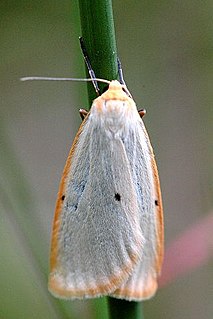
There are seven species of Australasian treecreeper in the passerine bird family Climacteridae. They are medium-small, mostly brown birds with patterning on their underparts, and all are endemic to Australia-New Guinea. They resemble, but are not closely related to, the Holarctic treecreepers. The family is one of several families identified by DNA–DNA hybridisation studies to be part of the Australo-Papuan songbird radiation. There is some molecular support for suggesting that their closest relatives are the large lyrebirds.

Noctuoidea is the superfamily of noctuid or "owlet" moths, and has more than 70,000 described species, the largest number of for any Lepidopteran superfamily. Its classification has not yet reached a satisfactory or stable state. Since the end of the 20th century, increasing availability of molecular phylogenetic data for this hugely successful radiation has led to several competing proposals for a taxonomic arrangement that correctly represents the relationships between the major lineages.

The Phaegopterina are a subtribe of tiger moths in the tribe Arctiini, which is part of the family Erebidae. The subtribe was described by William Forsell Kirby in 1892. 469 species of Phaegopterina are present and 52 that are recently discovered in Brazil.

Cybosia is a monotypic moth genus in the subfamily Arctiinae erected by Jacob Hübner in 1819. Its only species, Cybosia mesomella, the four-dotted footman, was first described by Carl Linnaeus in his 1758 10th edition of Systema Naturae.

Dysauxes is a genus of moths in the family Erebidae. The genus was erected by Jacob Hübner in 1819.

Eilema is a genus of moths in the subfamily Arctiinae. The genus was erected by Jacob Hübner in 1819.
Utricularia stygia, the arctic bladderwort or Northern bladderwort, is an affixed aquatic carnivorous plant that belongs to the genus Utricularia. U. stygia is native to northern Europe and North America. This species was originally published by Göran Thor in 1987 but the description was not in Latin and was therefore nomenclaturally invalid. Thor validly published the species a year later. The cited difference that separates U. stygia from U. ochroleuca is the shape of the tiny quadrifid glands inside the bladders, specifically at which angle the "arms" of these glands diverge from one another. Thor, when working on the Utricularia of Sweden noted that this distinction alone allowed for consistent species identification. Both Barry Rice and Peter Taylor have expressed concerns regarding how this method applies to other populations around the world.

Nudaria is a genus of moths in the subfamily Arctiinae erected by Adrian Hardy Haworth in 1809.

Pelosia is a genus of moths in the family Erebidae. The genus was erected by Jacob Hübner in 1819.
Zobida is a genus of moths in the subfamily Arctiinae.
Gardiner Island is one of the many uninhabited Canadian arctic islands in Qikiqtaaluk Region, Nunavut. It is a Baffin Island offshore island located in Frobisher Bay south of the capital city of Iqaluit.
Camp Island is one of the many uninhabited Canadian Arctic islands in the Qikiqtaaluk Region, Nunavut. It is a Baffin Island offshore island located in Frobisher Bay, southeast of the capital city of Iqaluit. Other islands in the immediate vicinity include Dog Island, Kungo Island, Luella Island, Metela Island, and Quadrifid Island.
Dog Island is one of the many uninhabited Canadian Arctic islands in the Qikiqtaaluk Region, Nunavut. It is a Baffin Island offshore island located in Frobisher Bay, southeast of the capital city of Iqaluit. Other islands in the immediate vicinity include Anchorage Island, Crowell Island, Kungo Island, Luella Island, Metela Island, and Quadrifid Island.
Crowell Island is one of the many uninhabited Canadian Arctic islands in the Qikiqtaaluk Region, Nunavut. It is a Baffin Island offshore island located in Frobisher Bay, southeast of the capital city of Iqaluit. Other islands in the immediate vicinity include Anchorage Island, Dog Island, Kungo Island, Luella Island, and Quadrifid Island.
Metela Island is one of the many uninhabited Canadian arctic islands in Qikiqtaaluk Region, Nunavut. It is a Baffin Island offshore island located in Frobisher Bay, southeast of the capital city of Iqaluit. Other islands in the immediate vicinity include Camp Island, Dog Island, Kungo Island, Quadrifid Island, and Sliver Island.
Sliver Island is one of the many uninhabited Canadian arctic islands in Qikiqtaaluk Region, Nunavut. It is a Baffin Island offshore island located in Frobisher Bay, southeast of the capital city of Iqaluit. Other islands in the immediate vicinity include Crowell Island, Kungo Island, Metela Island, Quadrifid Island, and Wedge Island.

The Erebidae are a family of moths in the superfamily Noctuoidea. The family is among the largest families of moths by species count and contains a wide variety of well-known macromoth groups. The family includes the underwings (Catocala); litter moths (Herminiinae); tiger, lichen, and wasp moths (Arctiinae); tussock moths (Lymantriinae), including the arctic woolly bear moth ; piercing moths ; micronoctuoid moths (Micronoctuini); snout moths (Hypeninae); and zales, though many of these common names can also refer to moths outside the Erebidae. Some of the erebid moths are called owlets.
"Scoturopsis" seitzi is a moth of the family Notodontidae first described by Hering in 1925. It is found in Bolivia.
Arctia olschwangi is a moth of the family Erebidae. It was described by Vladimir Viktorovitch Dubatolov in 1990. It is found in the polar Ural, Yamal Peninsula, Yakutia, Lena River delta.
Syllepte leucographalis is a moth in the family Crambidae. It was described by George Hampson in 1912. It is found in Indonesia (Bali).










